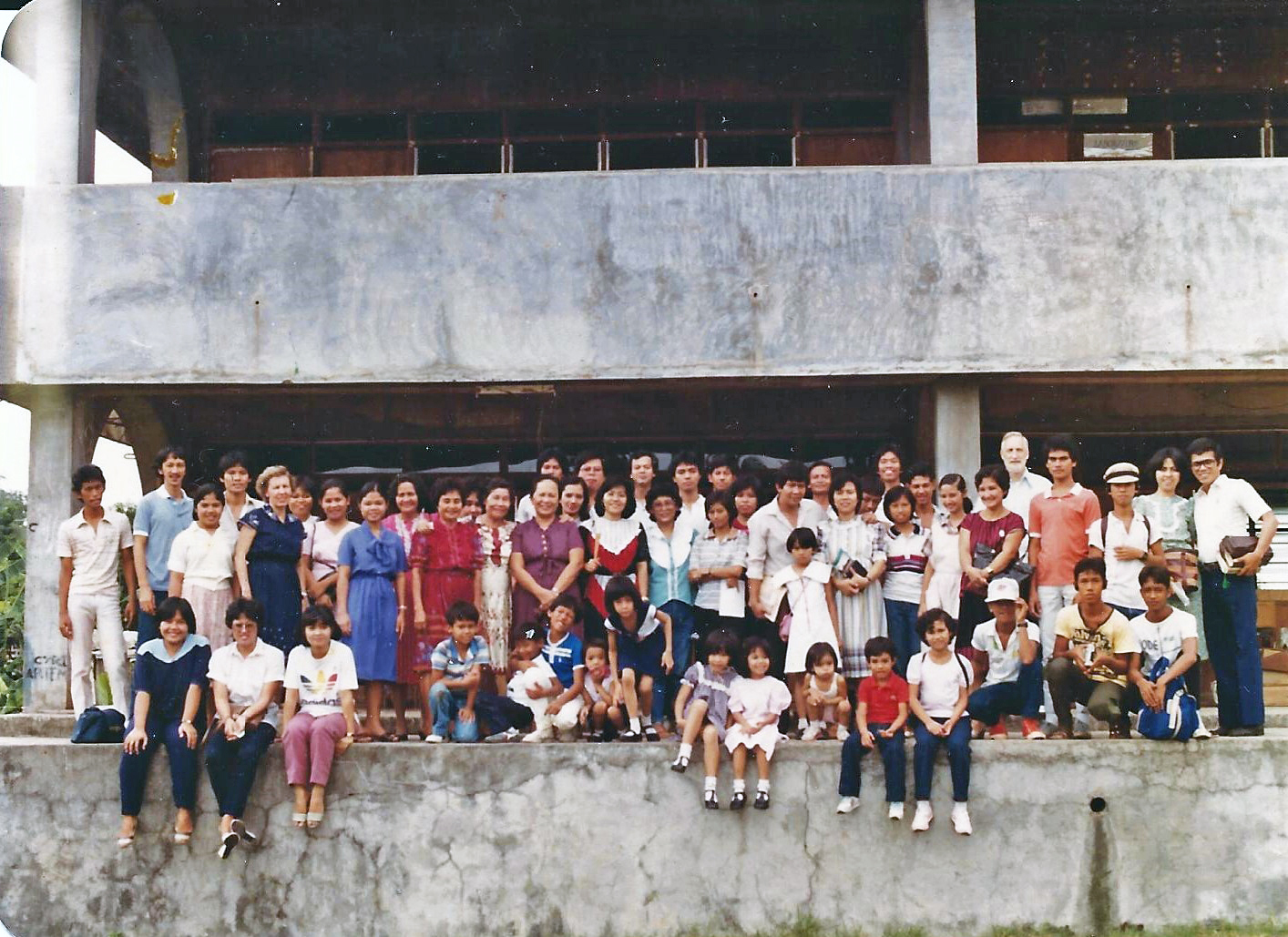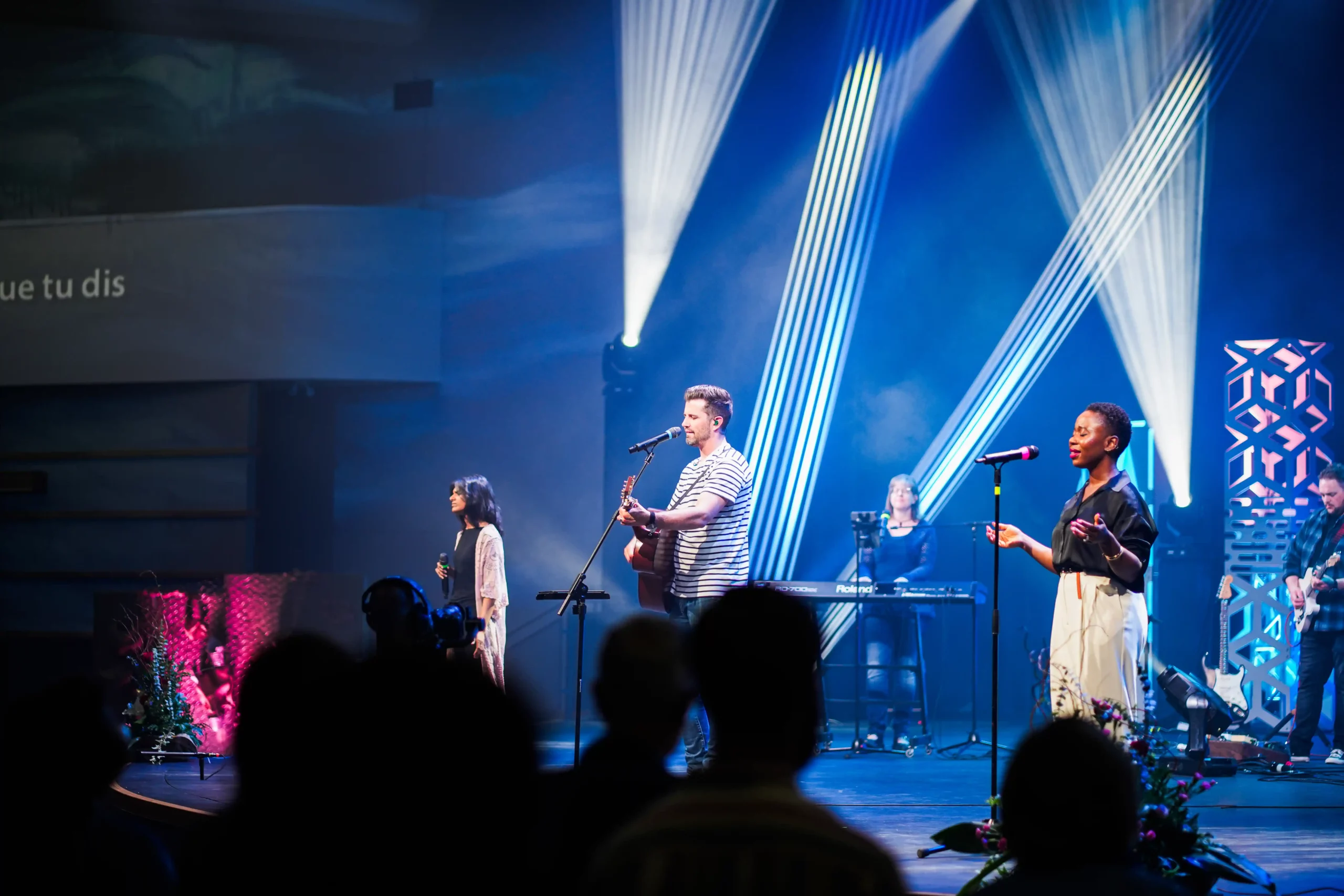In a squatter house along a drainage canal in Java’s cultural capital, we learned the power of prayer. Some months previously, in the same clapboard shack with a dirt floor, seven adults invited Jesus into their lives at the end of a Bible study. The head of the household had regularly welcomed anyone from the neighbourhood to come for Bible study, but now he was acting very strange. His adult son had insulted him because he was embarrassed that both his Mom and Dad had turned from Islam to trust Jesus as their Saviour.
His son’s insult triggered temporary insanity. Mr. Pye was running up and down the alley, naked, flailing a live chicken over his head while plucking its feathers with his mouth. One of Mr. Pye’s neighbours came over to tell him his behaviour was shameful. The more the neighbour scolded Mr. Pye, the more agitated he became. Not knowing what to do, we said, “Let’s pray.” The more we prayed, the more settled and quieter he became. We had never seen such dramatic and immediate results from prayer before.
Our Early Years
Wallace:
Growing up on a mixed farm in rural Alberta offered both advantages and disadvantages. Meat, milk, and vegetables were abundant, but my family’s only regular cash income was the cream cheque, which amounted to seven or eight dollars a week. Hard work on the farm helps to build character and the skill of innovation. When machinery broke down, the first solution was usually a metre or two of hay-wire or binder twine!
Our family home burned to the ground in the summer of 1955. Not long after, my father was diagnosed with multiple sclerosis. Progressive physical deterioration forced him out of farming and into temporary jobs that allowed him to remain seated while working. When God called me to ministry at age seventeen, I knew I could not count on financial assistance from my family. Paying college tuition would require faith and hard work.
My call to ministry came on the heels of an unlikely mid-teen conversion. Unfortunately, my grade ten friends were increasingly involved in dangerous lifestyle choices. Their fast cars, strong drink, and loose sexual relationships pressed me to find safer peers. I was warmly welcomed at the Stony Plain Alliance Church youth meetings. It was Easter 1961 when I heard the Gospel preached in such an inimitable way by Rev. E.A. Phillips that I felt compelled to repent and surrender my life to Jesus Christ.
About one year later, the yearbook committee at Memorial High School made the rounds, asking upcoming grads a few questions. One question was, “What do you plan to do after high school?” My ambition was to study electrical engineering at the University of Alberta, so I had my answer ready. However, when I opened my mouth, different words emerged, much to my surprise and embarrassment. I heard myself saying, “I will become a minister of the Gospel of Jesus Christ.”
Shortly after, I felt strangely compelled to apply to Canadian Bible College (CBC). To my surprise, I was accepted though I had no idea how I would pay my way. To my amazement, God provided all the necessary funds to complete the three-year program over four years.
Beverly:
It was a delightful experience to grow up in the Moose Jaw Alliance Church. Though church was a vital part of my experience, it was in our home at my mother’s knee where I received Jesus into my heart at a very early age. My Mom and Dad faithfully took us to church, where the emphasis was often on missions. Missionaries would tell their stories illustrated by slides while sharing how they served God in foreign countries.
When I was in grade ten, a visiting missionary invited all those willing to serve the Lord overseas to come forward in the evening service. I remember walking up the aisle, fully persuaded I wanted to give my life to God’s missionary work. At the same time, I wondered if God would notice such a young girl as me.
I went to Canadian Bible College in 1962 to prepare for overseas ministries. The Lord brought Wallace to my attention during our second year; he was president of the missions committee and a very dedicated young man. We fell in love and were married in 1965 in the college chapel.
Wallace taught me about prayer and perseverance, inspiring me with his love of Scripture. He has always been interested in facilitating others in their walk with the Lord. We served in several churches before he felt called to serve the Lord overseas, and my call to missions would be realized.
Church Ministries in Canada
Wallace:
After completing most of my work at CBC, I approached Rev. A.H. Orthner, district superintendent in the Canadian Midwest District, asking if there was a church in the Regina area where I could help out while completing my few remaining courses. He assigned me to Parry Alliance Church, which was likely the smallest Alliance church in Canada at the time. The congregation numbered thirty-five men, women, and children. We served from Friday evening to Sunday afternoon every weekend before returning to Regina, where Beverly was enrolled in the Teacher’s College at the University of Regina.
After completing her program, we moved to Ogema, where Beverly taught grade four, and I gave full-time to pastoring the congregation at Parry. We initiated evangelistic ministries and home Bible studies in several towns around the area from our new base.
When it became evident that Beverly was expecting a baby and unable to continue teaching through to the end of the year, Rev. Orthner asked me to candidate in a new church plant in Manitou, Manitoba. There seemed to be a vacuum in the community filled by the Alliance, and this new church rapidly grew to the building’s capacity.
After four wonderful years in Manitou, we were asked to move to Portage la Prairie, Manitoba, to help rehabilitate the church. It had been reduced to about five families when the nearby Canadian Forces base was scaled back. God filled the little building at least three times over the next six years, but families would move when summer came along, leaving the church weakened.
During our time in church ministry, we welcomed three children of our own to our family. They were the joy of our hearts. Torrey was born in Manitou in 1967, Valerie in Morden in 1968, and Megan in Portage la Prairie in 1976, all in Manitoba. We also welcomed twenty-seven foster children who needed a temporary refuge before being placed in a longer-term situation.
While we served at Portage la Prairie, William R. Goetz invited me to join his staff at Sevenoaks Alliance Church in Abbotsford, B.C. The ministry in Abbotsford was growing at an annual average rate of 15-20 percent. A steady flow of conversions fed a dynamic discipleship program. While serving as pastor of personal ministries at Sevenoaks, I was privileged to work on the district extension committee under Rev. Gordon Fowler for several years. Daughter churches were planted by Sevenoaks in Mission, Aldergrove, and Langley during the six years we served there.
One day I was sitting in the North Vancouver Alliance Church with a district sub-committee. After the meeting, Rev. W.H. Brooks, retired but still very active in his travel agency, placed his hand on my knee and asked, “Isn’t it time you led a group from Sevenoaks to the Holy Land?” I was nonplused and noncommittal. Later the same week, I visited an eighty-year-old lady who had recently become a new follower of Jesus. My intention was to ask her to consider baptism. Her response was, “Young man, I’m not getting baptized in your church. I’ll be baptized in the Jordon River, and you’re going to baptize me!” Nonplused for the second time in a week, I decided it was time to ask Beverly if she felt this might be God’s prompting.
Within weeks we were planning a trip to the Middle East. It was our first experience outside of North America. From the moment we landed in Amman, Jordan, I was fascinated by the culture. We woke early on our first day in Amman. While looking out over the city from our open hotel window at 4:00 am, we heard what seemed to be the wail of an injured dog. As the eerie sound multiplied into a cacophony of similar sounds, I realized it to be the fajr (sunrise) Muslim call to prayer. Hearing the dissonance of thousands of adzan (calls to prayer) from minarets across the city placed an inescapable burden for the Muslim world upon my soul that still moves me to tears as I recall that event.
After gaining agreement from each of our family members, I approached Rev. Dr. Arnold Cook about the possibility of overseas service. This was the era when the Canadian Alliance was exercising creative initiatives, one of which was sending people whom Dr. Cook described as “young geriatrics.” His intent was to bend the age rules a little to get more people into cross-cultural ministry.
Not only were we over the thirty-two-year age limit, but we also had three children, one of whom was a diabetic. Dr. Cook ignored the two-child limit and appointed us to the largest Muslim people group in Southeast Asia. He also ignored Dr. Frame’s health evaluation, in which we were warned that Torrey may die if we proceeded to our overseas assignment. Within nine months of our trip to the land of the Bible, we were on our way to Asia.
International Workers in Indonesia
Beverly:
Our first term overseas was filled with new experiences: learning a new language and the Javanese culture. After just three weeks, Harold Klassen, our senior missionary, predicted, “You know, you are really going to like living here.” I was not so convinced, but his prediction proved correct. The Indonesian people and the country mysteriously won our hearts. After language study in Bandung, we moved to Solo (Surakarta, the Javanese cultural capital) for our first church-planting assignment. We saw God do amazing things. He multiplied food, healed the sick and most wonderfully, He opened the hearts of people to receive Jesus. It was there that we met Mr. Pye and witnessed his journey to faith as well as his miraculous healing from diphtheria in answer to prayer.
This term also involved teaching Theological Education by Extension (TEE) across the south coast of Central Java. I loved to prepare the lessons and then teach in towns and villages. Sometimes our children would join us. We firmly “advised” them that they should be polite and eat whatever was served. They graciously complied and often did so with an inward grimace behind a smiling face.
Wallace:
Language study was not easy for a middle-aged couple, but God taught us how to build on each other’s strengths. I learned slowly but remembered vocabulary longer. Beverly picked up words and phrases quite quickly but lost them if they were not used regularly. By helping each other out, we found ourselves teaching in the national language after only five months of language study. Leading a Friday evening discipleship group provided powerful motivation for us to grow in our language ability.
Not long before we arrived for our overseas assignment, Indonesia’s Alliance mission adopted a new goal. They set about to plant five hundred new churches on the predominantly Muslim island of Java within a ten-year time frame. Fresh out of language school, we were sent to pioneer in a city where the Alliance had no churches. The strategy was to work hand-in-hand with young evangelists from Kalimantan, an area where our national church was strong.
We were assigned to work with Evangelist Zasterman, a gentle and caring man, the product of Frank and Marie Peters’s excellent teaching ministries at the Long Bia Bible School. Another Alliance lad joined us, bringing our team to four. Ayub hailed from Alor, a region where the church had experienced revival accompanied by miracles. Two churches and five evangelistic posts were formed over the three remaining years of our first term. It was in this context we learned how vital it is to let nationals take the lead. Both Zasterman and Ayub were still serving their congregations in Solo some thirty years later.
In the providence of God, sufficient funds were designated by our supporting churches to build two churches. Having developed cultural sensitivity through my studies at Fuller School of World Mission, it was decided to build each in the pendopo architectural style typical to this Central Javanese area. The mayor of the city drove by the first church and decreed that all churches built in that city henceforth must use the pendopo roof profile. We were pleased that contextual architecture helped us gain favour.
Having established a pattern of monthly baptismal services in Abbotsford, we aimed to follow that pattern in our new ministry in Central Java. Though we did not baptize people every month, we frequently saw baptisms throughout the year. Because both churches began in homes with limited space, we raised the sides of a fishpond in our own backyard, making it deep enough to immerse people.
Early in our days in Solo, we announced a baptismal service. The congregation consisted of no more than forty persons. We offered to host a lunch after the baptism, a cultural must for any sort of celebration in that area. Beverly prepared Soto-Ayam, a potato and chicken broth sufficient, she thought, for about forty people. We discovered the Javanese bring their friends along when invited to a celebration. We were overwhelmed by the crowd of people who came to our home. Penny, our helper and cook, counted how many times she had to rewash the dishes to serve more people. After the guests left, she reported that we fed more than one hundred and twenty people with three chickens that day. In her eyes and ours, this was nothing short of a miracle.
Our first term was not without its challenges. During this period, an illness on top of two huge disappointments plunged me into depression. It hit me on a Friday evening like a load of bricks on my soul. I just wanted to die. By Monday morning, all the depression had mysteriously disappeared. When I woke up, the illness and disappointments were unchanged, but the depression was gone. About two weeks later, I received a letter from Doug, a truck driver and friend I had led to Christ a few years earlier. More than half of his letter consisted of Scripture. He had been given prophetic insight into my situation, describing it perfectly on the thirteen pages of his letter in which he assured me of his prayers. To this day, I have no other explanation for my deliverance from depression. It was the effectual, fervent intercession of my friend.
In our second term, we were assigned to East Java. We travelled across the length and breadth of that province to teach TEE while helping plant a church in the city where we lived. On my first visit to the post office to mail a letter to our daughter at Dalat School, an imposing gentleman approached me with a question. “Do you know where I can find the Alliance missionary in this city?”
Dr. Patty had just moved to this city of 800,000 people from a university in Irian Jaya (now Papua). He had served on the Board of Directors of the Gospel Tabernacle Church 1 in that province. Someone had told him that Alliance missionaries had been assigned to plant a church in Malang where he had come to teach at a private university.
I understood his question correctly and answered, “I am he!” He must have thought I did not understand his question. He repeated it three times, to which I replied each time with, “I am he!” Finally, he understood. Would you say this was a mere chance? God was leading and providing! Professor Dr. Samuel Patty and his family became key supporters of the new work in Malang.
During our years of ministry in Java, Christmas was one long chain of special celebrations in churches spanning about six weeks or more. Christmas and Easter were also occasions for baptism. One year our family was invited to preach and baptize several new believers at a church in the provincial capital about 75 km from our home on Christmas Day. The service began at eight in the morning, so we decided to overnight in an affordable hotel so we would not have to get up and drive quite so early. We opened our gifts Christmas morning in that room that reeked of smoke. It was perhaps the worst Christmas ever for our family. The baptism service, however, made up for the lack of Christmas ambiance.
After three years in Malang, the annual field conference chose us to fill the field director and guesthouse manager’s roles for the year when our long-serving director, Gunther Kamphausen and his wife were on home assignment. This assignment took us to the end of our second term.
For ten years, from 1982 to 1992, I tucked into my ministry and home assignment schedule as many extension and intensive courses as I could from Fuller School of World Mission. My main objective was simply to obtain the tools to be more effective in our cross-cultural and church-planting ministries. At one point, Beverly observed I was within a semester of fulfilling the requirements for a degree and encouraged me to go for it.
Having been a field researcher for several years in Southeast Asia and living among the Madurese, I decided to write a thesis project on the history of mission among this people group, the second-largest unengaged group in the nation. Dr. Paul Hiebert mentored me through the project, enabling me to complete the requirements for an M.A. in missiology. My thesis provided historical perspective and motivational impetus for the placement of a C&MA team to that least-reached ethnolinguistic group in the mid-1990s.
On Staff at the National Ministry Centre
Wallace:
Weeks before the end of our home assignment of 1991-92, Dr. Arnold Cook called me at our home in Abbotsford. I was leaning back on my office chair reading my Bible at 7:00 am when I received his call. He got to the point quickly. He asked me to assume the position of vice-president, personnel and missions, which he vacated when he was elected as president of The Christian and Missionary Alliance in Canada. An involuntary jerk almost tumbled me backwards to the floor. I avoided disaster only by regaining balance when my feet hit my desk’s underside, popping my chair’s front wheels suddenly back to the floor. It took me a few minutes to regain composure. I explained that my calling was to return overseas to form a team among the unreached and unengaged Madurese. He asked me to at least pray about his proposal for a few days.
I struggled in prayer over his request. As I prayed, a new vision began to form in my mind. In this role, I would be able to place teams in multiple new unreached and unengaged people groups. Apparently, my vision for unreached and unengaged people groups matched his priorities as president. After appointment to the vice-president’s position by the Board of Directors, Beverly and I began visiting all Canadian Alliance overseas personnel. On each trip, I intentionally included visits to one or more countries where the C&MA was not working. My purpose was to check for least-reached people groups that were not yet served by any other mission.
The C&MA in Canada began several new initiatives during our time at the national office. This was just one factor leading to greater autonomy in these endeavours and the necessary change in the C&MA Canada’s partnership with the C&MA United States. 2
Beverly:
When Wallace was asked to take the role of vice-president for overseas ministries, we accepted with both joy and sadness. We were all ready to return to the field. Our daughter, Megan, was to leave in just a couple of days for her sophomore year at Dalat School in Malaysia. As we prayed, we realized that God was asking Wallace to do this, so Megan went back to Dalat to finish high school. We counted the days again until she would return for Christmas and the summer holidays.
Each of our children graduated from Dalat International School in Malaysia. Torrey went to be with the Lord in 1987 as a result of a car accident. Currently, Valerie and her husband Brian joyfully serve at the Dalat International School. Megan is now serving as president of an agency that assists non-profit and charitable organizations in raising funds. How we thank the Lord for our children and their families.
Wallace kept very busy working in his new role. I also joined the national office staff as an administrative assistant to the Vice-President of General Services, Ken Paton. Dr. Cook required that I join Wallace on his first two years of overseas trips.
When the Canadian Alliance began to manage its own mission effort, Wallace invited Gerald and Dorothy Hogenbirk to lead in the Europe/Middle East area, Harold and Becky Priebe in Latin America, Ron and Myra Brown in Africa and Brem and Donna Frentz in the Asia Pacific Region. Each couple was extraordinary in their unique contribution to developing our Global Ministries. It was such a joy to work together with these four couples and see God’s hand in their lives and ministries.
During this period, Dr. Cook mandated the redeployment of Canadian Alliance mission personnel to the least reached. Redeployment was not always comfortable, especially when our personnel were moved to nations where they were required to learn a new language. Whenever challenges arose in any part of the world, Dr. Cook would call us to prayer and in every case, the Lord came to our rescue.
Wallace:
The involvement of the vice-president, global ministries became less and less critical in regional initiatives as the four regional developer couples (whose areas are now known as Silk, Sand, Spice, and Sun) expanded their roles in the late years of the last century. That left me, as vice-president, involved mainly in the budget, administrative, and personnel challenges. I could not imagine myself crunching numbers and resolving personnel issues for another eight to ten years up to retirement age. One day I picked up a little publication in Barnes and Noble’s bookstore in Wheaton, Illinois. It posed the question, “Who moved my Cheese?” I devoured the short story in less than twenty minutes and concluded my “cheese” was no longer found in the National Ministry Centre.
I inquired discreetly with the regional developers in the Asia-Pacific Region, Brem and Donna Frentz, if they would accept Beverly and me as international workers. Brem’s eyes widened for a few moments before he regained enough composure to respond. We shared our plan with him: a new initiative among an unengaged people group with no church in its cultural and linguistic context.
I began doing research. Field leaders in the nation where we had previously served printed a brochure highlighting the five least-reached people groups with whom they felt God would have them engage. One of the five was a people group of almost three million. We approached the field leaders and asked if they would be interested in this becoming a Canadian initiative. They agreed.
During my travels as vice-president of personnel and missions (changed to VP-global ministries in 1997) for the C&MA in Canada, I began noting certain phenomena related to receptivity. While visiting with Blaine and Shelly Sylvester in Côte d’Ivoire, I learned they, along with students and national pastors, had been instrumental in planting twenty-five new churches in just two years. Gathering people and getting professions of faith were relatively easy tasks among the Bambara-speaking people.
In contrast, I discovered that it took the average missionary couple approximately five years to see someone become a Christ-follower in Morocco. As we entered post-Communist Russia, our workers there told me that the average person needed to hear the Gospel about ten times before the concept of grace began to sink in. I started gathering material on receptivity to the Gospel motivated by the mission administrator’s need to know where and when to invest mission personnel and resources.
Beverly:
In early 2001 we took vacation time to look after Val and Brian’s children in Wheaton, Illinois, while they were leading a short-term mission team to Cambodia. Wallace and I asked each other the question, “If we could do anything, not worrying about money, people, or any other issues, what would you like to do with our final decade of formal ministry?” We both answered, “to engage in a pioneering effort overseas.” We still remembered the language we had learned during the 1980s in Indonesia and felt energized to use it once again.
Not long after this epiphany, we attended the Canadian Theological Seminary- East opening at Bayview Glen Church in Toronto. Ben Heppner sang, “The blood shall never, never, never lose its power.” He sang with such power and intensity; we were deeply moved. Wallace and I felt that if this message is that powerful, we must return to the field and share this good news with those who have never heard. So began the process of our return to overseas ministry.
Wallace:
After two years of preparation from 2002 and 2003, our team moved into a somewhat hostile Muslim environment. Our prayer had been, “Lord, lead us to some nice Soli people.” 3 The prayer sprang from a riot in 2000 where all Christians were chased off the island, and the twelve or so existing churches serving non- Soli minorities on that island were burned. Though the task was not without its challenges, God led clearly in so many ways it would take a small book to recount.
An entry path was the most significant early challenge. God had led me to enroll in a doctoral program in Singapore three years previously. I drafted a research proposal and submitted it to the nation’s Institute of Sciences, which granted me a two-year research visa. Then we felt led to form a national non-profit development organization as our entry-path into the country.
Least-Reached People in Southeast Asia
Beverly:
During the staging period preparing for our initiative amongst this least-reached people group (LRPG), we worked with a veteran missionary in the International Church in Bali. We had beautiful times of prayer, ministry, and renewing our language fluency. During this time, I suffered a heart attack and had quadruple bypass surgery in Singapore. Five months later, I was hit by a motorbike while Wallace and I were crossing a main thoroughfare on our way home from exercising. I sustained five broken bones, none of which could be secured by a cast. Though the pain was extremely intense, I shall never forget the joy I had bubbling up in my heart while I rested on a green rubber sheet in the hospital. I realized then that no matter what we are called upon to endure, one’s joy can never be taken away because God is in us, and He is JOY.
Miracles continued as we engaged this new people group. We knew no one, and people told us it would take up to 10 years before seeing anyone follow Jesus. The year before we left for the field, I had a very strong prompting to take some art lessons. I drove several miles in the winter just to do this, not knowing what the urgency was. I loved watercolour painting and found it opened a new part of me that was previously hidden. Little did we know this interest in art would open the doors for us in our new assignment.
A few days after we arrived on the island, a local artist visited our home after all our pictures were hung. He had heard I was interested in art and wanted to see some of my paintings. He offered to take us to all the artists’ homes on the island so we could work together. It was just weeks later we sat in their homes planning an art exhibition at a local resort, which in turn opened the door for many new friendships. Truly the Lord works ahead of us as He knows and plans our future. We were overjoyed. There was only one Christian artist on the island, and he became one of the most valued leaders in the national development organization we helped establish. The Lord provided the funds to rent a place and create a Coffee House/ Art Gallery. Another family joined our team and helped work out all the details for this lovely place of ministry.
During our first team planning event, we agreed to pray for God-called national workers to come to us rather than going all over the country recruiting them ourselves, which was the method others often used. The Lord answered our prayers by bringing two beautiful couples into our lives. They became the backbone of our work there. One was an evangelist who has won scores of people to the Lord. The other couple were hard-working teachers. They were great friends as well as wonderful servants. We honour them highly and know their labours will be rewarded someday in glory. Other team members came and went along the way. We are so thankful to the Lord for each gift they gave to the work of His Kingdom among the Soli people.
Wallace:
Beverly and I did not make a practice of praying together regularly until 2002. Having been planted in a context where indigenous religions (Hindu and Muslim) maintain rigid devotional patterns, we felt the urgent need for divine guidance every day, so we began the discipline of extended morning prayer times imploring the Lord for direction. This discipline has been a fountain out of which creative energy was generated for all we have seen God accomplish in our ministries among highly-resistant people.
Combining human development programs with church-planting is not always an easy combination. In this hostile context, it was necessary to engage in research and development efforts in the day-time hours while training and strategizing for Kingdom development in the evenings and weekends. Keeping those two worlds separate was delicate at times and dangerous at others. Our friendships with local Muslim partners in the areas of art and development served to get us past more than one tense situation with government officials who would have liked to expel us from the island.
In 2001, I noticed a new post-graduate program at Bethany International University (BIU) in Singapore. I inquired and eventually enrolled in the Doctor of Missiology program there. Moving to Southeast Asia in 2002 brought me a lot closer to the campus and my mentor, who guided me through several years of independent research and writing.
The BIU program follows the European methodology: entrance to the program was conditional upon the successful defence of one’s proposal. After my first doctoral seminar was submitted, Dr. Sudhir Isaiah recommended that my research subject fit more appropriately into a Ph.D. program. He convinced me to upgrade. The responsibilities of my mission assignment dictated I complete the doctoral seminars in intervals when time availed. My research took me to several libraries in both Asia and North America.
In November 2010, I was successful in defending my dissertation, “Factors and Measures of Resistance and Receptivity to the Communication of the Gospel: Tools for the Intercultural Strategist Engaging Least Reached People Groups.” The central contribution made by this project is an inventory consisting of fifty questions. The score obtained among a specific people group would indicate with greater precision than previously possible the group’s relative receptivity or resistance to the Gospel based on historical, anthropological, spiritual, theological, socio-political, missiological, and communication factors. The instrument was designed to sensitize international workers who serve in resistant contexts to mitigate resistance wherever possible.
Conclusion
Wallace:
As I look back on my departure from the farm near Stony Plain, Alberta, I must admit I was a slow starter. Despite this reality, my life’s theme from the time I became a follower of Christ onward has motivated me to reach beyond my church, community, and country.
When I was a young pastor, I struggled to maintain a regular, soul-nurturing, quiet time. As a type-A personality, doing was my default behaviour. In the mid- 70s, Youth with a Mission (YWAM) published a personal diary offering three key features: a calendar, a read-through-the-Bible-in-one-year schedule, and thumb-nail sketches of unreached people groups. With this guide, I began reading through Old and New Testaments annually and reading the Psalms and Proverbs twice each year. This pattern became a life habit sustaining me over difficult periods in my life.
The last half of my life has been spent reaching out to or motivating others to take the Gospel to those who have never heard of Jesus Christ. While other mission agencies were engaging people groups where two to twenty-five percent were already in the church, Canadian Alliance efforts focused on people groups where 99.9 percent or more had never heard the Gospel.
Beverly:
When we look back at our lives, we feel so humbled and very grateful to the Lord, who loves us and called us to His vineyard. We did so little, but God did so much. It often seemed like we were just standing on the sidelines watching Him work. He is so powerful, so faithful, so loving. How could we ever be so blessed to walk with Him? From our experiences, I have learned I should never doubt God even when it looks like He is not working.
I love to read. Books have become good mentors for me. Early in my college days, I was most inspired by the book, We Would See Jesus by Roy Hession. Later, while in international ministries, I learned much from LeAnne Paynes’ books, Listening Prayer, Restoring the Christian Soul and The Healing Presence.
I have learned that it is wonderful to pray and to expect great things from Him. The reward of His presence is incredible; nothing is more exciting or rewarding. I have learned that in the darkest valleys when the testing is most severe, He will not leave us, not even for a moment. My lifelong desire has been to live for Jesus, and I can honestly say He has always been faithful. All the glory belongs to Him!
This is an excerpt from the book, On Mission Volume 1. Download your free copy today.
- The Gospel Tabernacle Church of Indonesia (Gereja Kemah Injil Indonesia) is the sister church of the C&MA with whom Alliance missionaries worked.
- For more on how this took place, see Making God Known: To Least-Reached People in Extraordinary Ways, pages 3-11
- Soli is a code name frequently used by international workers when referring to this people group. The code name is used here in order that the identity of the Canadian Alliance workers who continue to work among this people group are protected.
Share:
Find more posts about:
The Alliance Canada
Support the mission
The Global Advance Fund (GAF) is a pooled fund that supports our workers in Canada and around the world to share the Gospel with people who haven't yet heard the name of Jesus. Your continued generosity equips and sustains our workers and their ministry.







